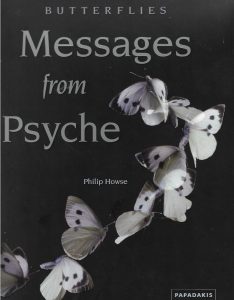Butterflies, Messages from Psyche, by Philip Howse, 2010, Published by Papadakis (An imprint of New Architecture Ltd, Winterbourne, Berkshire). 192p. ISBN 9 781 901 092806. ISBN. 978 1901092806. Large 24x30cm.
I would of course be biased in the review of this book as it has the Cabbage White on its cover, and I did my PhD thesis on this very successful species that has colonised much of the northern hemisphere and is doing its best in the south. I am also biased because I love butterflies, have written several books on butterflies, have worked and published with Dame Miriam Rothschild on butterflies, as she loved butterflies too. In fact my 157 letters from her are precious. She is mentioned by the author of this book alongside Darwin, Wallace, Bates, Fabre, Hinton and, as Howse says she ‘stands apart amongst entomologists , and the basis of many of my ideas have come from reading her publications.’ I would agree, and this Psyche book reminds me of one particular book by Miriam ‘Butterfly cooing like a Dove’ (Doubleday, 1991). For Psyche think Keats ‘Ode to Psyche’.
Philip Howse is also a butterfly lover, and the book is butterfly-centric throughout, not forgetting moths, especially day-flying ones which have to express themselves rather better than nocturnal ones. Miriam was always fascinated by the reasons for everything, particularly colour, and she told me many times that there must be a reason for every particular colour on an insect, even if you have not worked out what it is. Of course, we have worked out what makes colour chemically, about pigmental colours, and structural colours, and how caterpillars sequester particular pigments for ornament, or poisons for defence, but the world is more evolutionary-sophisticated than that; there is the world of eyes and shapes and ‘clever’ visual deception that has evolved too, in a world replete with merciless hungry predators.
What Howse, and Miriam before him, have tried to do, is interpret the complicated and superbly biodiverse world of insects and other invertebrates, an almost impossible task as there are 40K invertebrates in Britain as an example. The book reminds me a wander through the rooms of the Rijksmuseum in Amsterdam with a plethora of fine detail of marginal insects popping up as if they were always part of the countryside scene, which is what they were then. Not add-ons in today diminishing biodiverse world.
In the world of art through time much has been inspired by nature. This book brings together some of the earliest examples from cave paintings, the apparent symbolic patterns on insects, such as the death’s head hawk moth – with discourses on ‘skulls and symbols’, snakes, eyes, bird icons and goddesses as chapter headings.
What one has to consider is that here we are trying to interpret the myriad of colours and designs that have taken millions of years to evolve, possibly at least a million years before man was even evolved. Natural Selection is a powerful thing, and Howse sets about providing explanations of how living things have evolved together, mammals and insects, birds and insects, plants and insects, and how insects have taken advantage of the great biodiversity of life to successfully integrate themselves into the environment without being eaten. Continued good luck to them. A good deal of subjects in the book are aposematic i.e. ‘want to be seen’ with their bright symbolic colours and designs, other than cryptic or camouflaged, or both when in different situations (‘clever’). We are just outsiders looking in. Invertebrates are the most successful animals on earth.
Who would put a caiman and a lantern fly together on a page, but Howse has? I have been in the Amazon and marvelled at the bizarre shape of lantern flies, and handled baby caiman and not considered the connection. But yes, why not. We have in this book a glimpse into the diverse world of colour deception. Bates and Muller were both engaged in trying to explain mimicry, so too Miriam and Howse.
This book is a tribute to mimicry in butterflies and mimicry examples pervade the book, butterflies with eyes, butterflies with spines, butterflies like leaves etc. To survive in the living world butterflies must evolve, fast, to deceive and become invisible. I particularly liked the juxtaposition of the fox’s face and eyed-hawk moth, or the robin and the Meadow Brown butterfly, or even kestrels and fritillaries.
Philip Howse OBE was a lecturer at Southampton University and this is one of his many books. The book is large format, professionally produced as a superb photographic book, picture-perfect colour reproduction with full pages of butterflies and more butterflies. There is an index and chapter notes for further information. Overall a delight; especially as it has such a striking aposematic butterfly on its cover.
